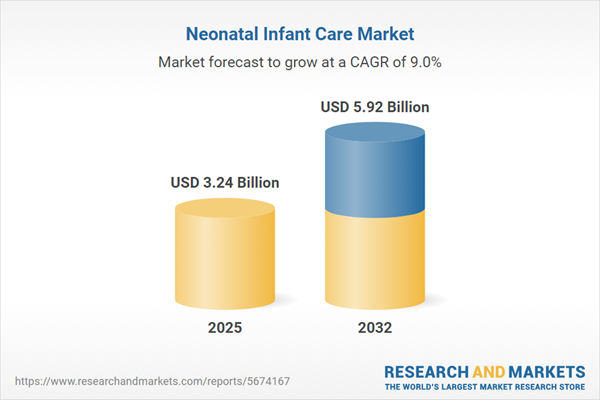Speak directly to the analyst to clarify any post sales queries you may have.
The Neonatal Infant Care Market is evolving through a convergence of digital health, advanced medical devices, and modernized clinical protocols. Leaders managing this transformation must balance strategic investments and workforce readiness with technology adoption and regulatory compliance.
Market Snapshot: Neonatal Infant Care Market Growth and Outlook
The Neonatal Infant Care Market is set for robust growth, with market size anticipated to reach USD 3.24 billion in 2025 from USD 2.97 billion in 2024, driven by a compound annual growth rate (CAGR) of 8.97%. By 2032, the sector is projected to achieve USD 5.92 billion. Expansion stems from widespread adoption of advanced neonatal monitoring and therapeutic devices, a greater reliance on integrated, data-driven solutions, and continuous optimization of clinical workflows. Shifting regulatory frameworks are prompting providers to strengthen compliance and transparency, which is accelerating the uptake of digital health innovations, new therapies, and sophisticated medical equipment. Regional patterns reflect varying levels of readiness and resources, influencing technology procurement, service delivery models, and organizational strategies across neonatal care environments.
Scope & Segmentation: Opportunities in Neonatal Infant Care
- Product Types: Infusion pumps deliver precise medication dosages; heated warmers and incubators sustain optimal thermal support; phototherapy systems including fibre optic, fluorescent, and LED models are used for jaundice management; respiratory equipment such as CPAP units and neonatal ventilators provide vital breathing assistance for infants requiring critical care.
- End Users: Hospitals, ambulatory surgical centers, specialty clinics, research teams, and home-care agencies together build an integrated care network that spans inpatient settings, outpatient facilities, and home-based support.
- Distribution Channels: Direct sales, wholesaler networks, e-commerce sites, manufacturer portals, supplier partnerships, and pharmacy retailers collectively extend access to neonatal care technologies into different types of healthcare organizations and markets.
- Applications: Market-leading devices support intravenous therapy, phototherapy, respiratory care, patient monitoring, blood gas assessments, and the regulation of environmental conditions, ensuring a comprehensive clinical safety net for neonatal patients.
- Therapeutic Areas: Devices are deployed in the management of core neonatal challenges: hypothermia, hyperbilirubinemia, withdrawal syndromes, respiratory distress, and sepsis, integrating closely with up-to-date clinical protocols and evidence-based practice.
- Regions: Americas and Europe invest in enhanced digital integration, clinical data connectivity, and system interoperability; Asia-Pacific’s adoption is skewed by reimbursement structures and the quality of healthcare infrastructure in markets like China, India, and Japan; Latin America places emphasis on portable, mobile-friendly technologies to improve rural care, while established economies prioritize continued compliance investment and technology upgrades for health system resilience.
Key Takeaways: Strategic Insights for Senior Leaders
- Digital health systems are foundational, enabling streamlined information sharing, optimized procedures, and collaboration across multidisciplinary teams within neonatal care units.
- Adapting to disparate regulatory requirements and reimbursement policies requires technology selection that is flexible, supporting compliance while enabling scale across organizations and regions.
- Modular, adaptable equipment positions healthcare settings to respond to rapidly changing medical needs, protecting service continuity and allowing effective risk mitigation.
- Regional differences shape investment decisions; developed markets may emphasize analytics and system integration, while emerging areas focus on affordability, scalability, and user-friendliness to bridge resource gaps.
- Supplier partnerships and resilient supply networks are vital for maintaining operational continuity and patient safety, particularly as global supply chains face uncertainty.
- Ongoing professional development, including staff training and digital literacy initiatives, maximizes return on technology investments and secures adherence to current clinical standards.
Tariff Impact: Navigating US Import Policy Changes
Recent tariff adjustments affecting US imports of infusion and phototherapy system components have caused healthcare providers to strengthen their supply chain strategies. By diversifying sourcing with nearshoring approaches and expanding supplier relationships, organizations can maintain device availability, ensure service agreements are met, and better shield themselves from import-related disruptions.
Methodology & Data Sources
This analysis relies on comprehensive secondary research, supplemented by structured interviews with frontline neonatal clinicians, procurement professionals, and technology leaders. Validation processes draw from regulatory filings, respected market intelligence reports, and current industry best practices to ensure data quality and actionable insights.
Why This Report Matters
- Supports executives in making confident, evidence-based decisions on technology adoption, compliance, and operations during periods of sector transition.
- Provides detailed segmentation and regional perspectives, guiding resource allocation and growth planning tailored to local regulatory and clinical priorities.
- Offers practical guidance for improving care delivery, operational resilience, and workforce development within diverse healthcare environments.
Conclusion
Continued investment in advanced neonatal care technology, strengthened supplier partnerships, and focused workforce development equip organizations to achieve clinical excellence and operational sustainability in the evolving neonatal landscape.
Additional Product Information:
- Purchase of this report includes 1 year online access with quarterly updates.
- This report can be updated on request. Please contact our Customer Experience team using the Ask a Question widget on our website.
Table of Contents
3. Executive Summary
4. Market Overview
7. Cumulative Impact of Artificial Intelligence 2025
Companies Mentioned
The companies profiled in this Neonatal Infant Care market report include:- General Electric Company
- Koninklijke Philips N.V.
- Drägerwerk AG & Co. KGaA
- Medtronic plc
- Natus Medical Incorporated
- Nihon Kohden Corporation
- Cardinal Health, Inc.
- B. Braun Melsungen AG
- Becton, Dickinson and Company
- Masimo Corporation
Table Information
| Report Attribute | Details |
|---|---|
| No. of Pages | 185 |
| Published | October 2025 |
| Forecast Period | 2025 - 2032 |
| Estimated Market Value ( USD | $ 3.24 Billion |
| Forecasted Market Value ( USD | $ 5.92 Billion |
| Compound Annual Growth Rate | 8.9% |
| Regions Covered | Global |
| No. of Companies Mentioned | 11 |









